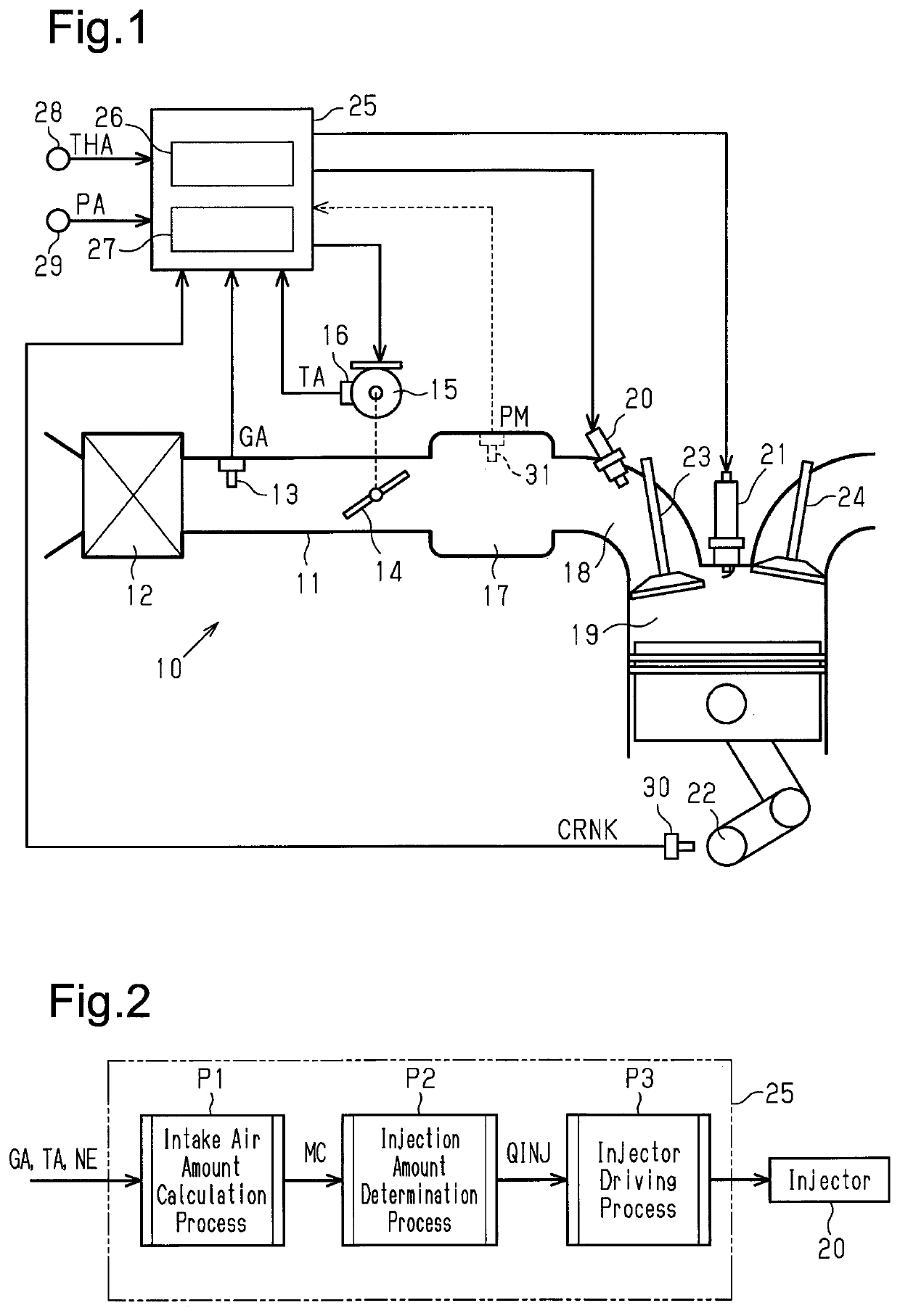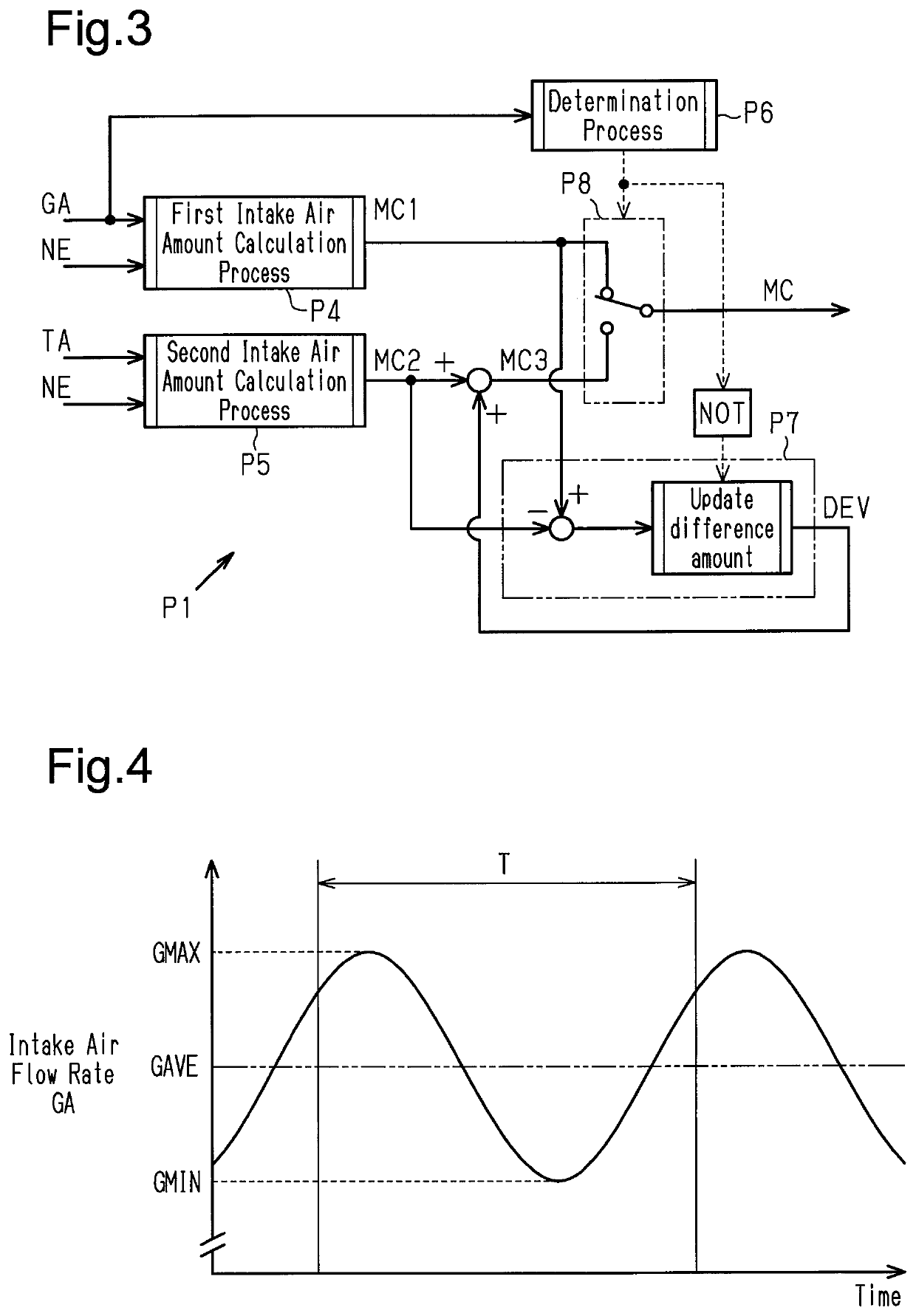Engine controller and engine control method
a technology of engine controller and engine, which is applied in the direction of electric control, machines/engines, output power, etc., can solve the problems of reducing the exhaust performance of the engine, reducing and reducing the detection accuracy of the intake air amount of the airflow meter, so as to improve the calculation accuracy of the first intake air amount and reduce the effect of engine exhaust performan
- Summary
- Abstract
- Description
- Claims
- Application Information
AI Technical Summary
Benefits of technology
Problems solved by technology
Method used
Image
Examples
first embodiment
[0071]An engine controller according to a first embodiment will now be described with reference to FIGS. 1 to 6.
[0072]FIG. 1 shows an engine 10 for which the engine controller of the present embodiment is employed. The engine 10 includes an intake passage 11. An air cleaner 12 that filters dust or the like in intake air is arranged on the most upstream side of the intake passage 11. An air flowmeter 13 that detects an intake air flow rate is arranged in the portion of the intake passage 11 located downstream of the air cleaner 12. Further, a throttle valve 14 for adjusting the intake air flow rate of the intake passage 11 is arranged in the portion of the intake passage 11 located downstream of the air flowmeter 13. In the vicinity of the throttle valve 14, a throttle motor 15 and a throttle sensor 16 are arranged. The throttle motor 15 opens and closes the throttle valve 14, and the throttle sensor 16 detects the opening degree (throttle opening degree TA) of the throttle valve 14....
second embodiment
[0098]An engine controller according to a second embodiment will now be described also with reference to FIG. 7. In the present embodiment and each of the embodiments described later, like or same reference numerals are given to those components that are the same as the corresponding components of the above-described embodiment. Such components will not be described in detail.
[0099]In the structure of the engine 10 for which the engine controller of the present embodiment is employed, an intake pipe pressure sensor 31 shown by the broken line in FIG. 1 is added to the structure of the engine 10 of the first embodiment. The intake pipe pressure sensor 31 is arranged in the portion of the intake passage 11 located downstream of the throttle valve 14 (i.e., arranged in the intake manifold 17). The intake pipe pressure sensor 31 detects the pressure of intake air in this portion (hereinafter referred to as intake pipe pressure PM). The detection signals of the intake pipe pressure senso...
third embodiment
[0103]An engine controller according to a third embodiment will now be described also with reference to FIGS. 8 to 10.
[0104]In the engine controller of the present embodiment, an air model, which is a physical model of the intake system of the engine 10, is used to estimate the intake air amount. The air model is configured by sub-models including a throttle model M1, an intake pipe model M2, an intake valve model M3, and an air cleaner model M4.
[0105]The throttle model M1 is a physical model for the behavior of intake air in the throttle valve 14. More specifically, the throttle model M1 includes, as variables, a throttle upstream pressure PAC, the intake pipe pressure PM, an upstream temperature THAC, and the throttle opening degree TA. From the relationship of a constriction expression (1), the throttle model M1 calculates and outputs the flow rate of intake air passing through the throttle valve 14 (throttle passing intake air amount MT). The throttle upstream pressure PAC repre...
PUM
 Login to View More
Login to View More Abstract
Description
Claims
Application Information
 Login to View More
Login to View More - R&D
- Intellectual Property
- Life Sciences
- Materials
- Tech Scout
- Unparalleled Data Quality
- Higher Quality Content
- 60% Fewer Hallucinations
Browse by: Latest US Patents, China's latest patents, Technical Efficacy Thesaurus, Application Domain, Technology Topic, Popular Technical Reports.
© 2025 PatSnap. All rights reserved.Legal|Privacy policy|Modern Slavery Act Transparency Statement|Sitemap|About US| Contact US: help@patsnap.com



